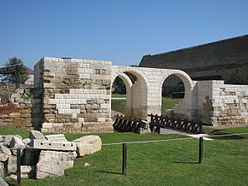Apulum (castra)
Appearance
| Apulum | |
|---|---|
 Porta Principalis Dextra | |
| Alternative name(s) | Apula,[1] Apulon[1] |
| Known also as | Castra of Alba Iulia |
| Founded during the reign of | Trajan |
| Founded | 107 – 108[2] |
| Abandoned | 4th century AD |
| Attested by | Tabula Peutingeriana |
| Place in the Roman world | |
| Province | Dacia |
| Administrative unit | Dacia Apulensis |
| Administrative unit | Dacia Superior |
| Directly connected to | |
| Structure | |
| — Stone structure — | |
| Size and area | 440 m × 430 m (18.9[2] ha) |
| Stationed military units | |
| — Legions — | |
| Location | |
| Coordinates | 46°04′04″N 23°34′22″E / 46.0679°N 23.5727°E |
| Altitude | 245 m |
| Town | Alba Iulia |
| County | Alba |
| Country | |
| Reference | |
| RO-LMI | AB-I-m-A-00001.01[3] |
| RO-RAN | 1026.01[6] |
| Site notes | |
| Recognition | |
| Condition | Ruined |
Apulum was a fort in the Roman province of Dacia in the 2nd and 4th centuries AD, located in today's Alba-Iulia, Romania.[6] It is the largest castrum located in Romania, occupying 37.5 hectares (93 acres) (750 x 500 m2).
The types of coins discovered
| Issuer | Issue Date | Type |
|---|---|---|
| Antoninus Pius | 139 | sestertius[7] |
| Julia Maesa | 218–224 | denarius[7] |
| Elagabalus | 222 | denarius[7] |
| Severus Alexander | 223–225 | denarius[7] |
| Sallustia Orbiana | 225–227 | denarius[7] |
| Gordian III | 241–243 | denarius[7] |
| Philip the Arab | 244–247 | antoninianus[7] |
| Cornelia Salonina | 257–258 | antoninianus[7] |
See also
Notes
- ^ a b Schütte, Gudmund (1917). "Ptolemy's maps of northern Europe, a reconstruction of the prototypes". The Royal Danish Geographical Society. Retrieved 2013-05-04.
- ^ a b Domșa, Ovidiu (2009). "Virtual reconstruction of Roman military Apulum camp" (PDF). p. 6. Retrieved February 14, 2013.
- ^ a b "Lista Monumentelor Istorice 2010 ("2010 List of Historic Monuments")" (PDF). Monitorul Oficial al României, Partea I, Nr. 670 ("Romania's Official Journal, Part I, Nr. 670"), page 3. Ministerul Culturii şi Patrimoniului Naţional. 1 October 2010. Archived from the original (PDF) on 2012-06-10. Retrieved 2012-12-30.
{{cite web}}: Unknown parameter|deadurl=ignored (|url-status=suggested) (help) - ^ Constantin C. Petolescu: Dacia – Un mileniu de istorie, Ed. Academiei Române, 2010, ISBN 978-973-27-1999-2
- ^ Academia Română: Istoria Românilor, Vol. 2, Daco-romani, romanici, alogeni, 2nd. Ed., București 2010, ISBN 978-973-45-0610-1
- ^ a b "1026.01". National Archaeological Record of Romania (RAN). ran.cimec.ro. 2010-10-22. Archived from the original on 2013-12-19. Retrieved 2012-12-30.
{{cite web}}: Unknown parameter|deadurl=ignored (|url-status=suggested) (help) - ^ a b c d e f g h "Apulum Archaeology". Retrieved 2013-05-02.
External links
 Media related to Castra Apulum at Wikimedia Commons
Media related to Castra Apulum at Wikimedia Commons- Apulum Archaeology
- Roman castra from Romania – Google Maps / Earth

